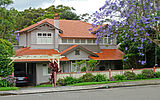Lindfield, New South Wales
This suburb of 5.17 square kilometres contains residential housing of California bungalow and federation style, in double brick and tile construction. Australian native bushland in Garigal National Park and Lane Cove National Park borders the suburb.
History
Lindfield was originally the home of the Kuringgai indigenous people.
Europeans first became active in the area in around 1810, when the colonial government set up a timber gathering camp staffed by convicts. The first land was granted in 1815 as a settlement when farmers cultivated the area. By the 1840s, fruit growing and farming became the suburb's primary industries. Settlement began to increase in the latter half of the nineteenth century. The Lindfield railway station opened in 1890, and Lindfield Post Office opened on 5 January 1895. Land values increased in the area around the railway and more professionals moved into the area.
The name "Lindfield" means a clearing in the lime forest, and derives from the name given by an early landowner, Francis List, to a cottage he built in the area in 1884. List likely named his cottage after Lindfield, Sussex, England. When a railway line came through the area in 1890s, the name of the property was used to identify the station and neighbourhood.
Lindfield saw significant development during the early 20th century, with a mix of housing, schools and commercial buildings. It bolstered the expansion of public transport, including bus routes, and later, the introduction of trolley buses in the 1930s. It became a popular area for families looking for a suburban lifestyle in close proximity to the Sydney CBD.
During the years after World War II the suburb experienced significant growth.
Heritage listings
Lindfield has a number of heritage-listed sites, including:
- 33 Tryon Road: Tryon Road Uniting Church
Tourism
Lindfield has a pleasant suburban village-like atmosphere. The suburb is mostly residential and its leafy neighbourhoods include a range of best preserved period-style detached houses. An attraction is the Seven Little Australians Park, a nearby bushland park, for which it received its name from a classic Australian children's novel.












